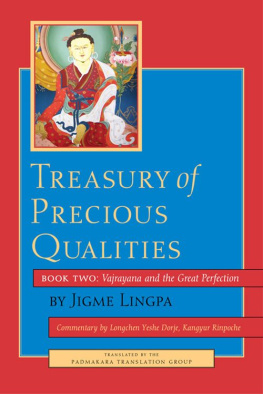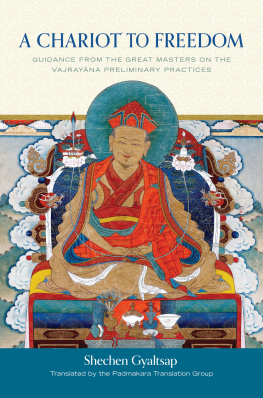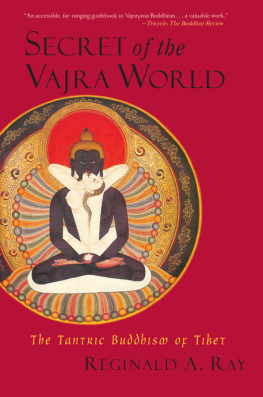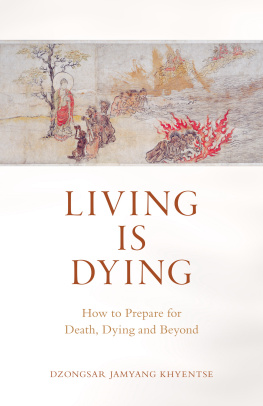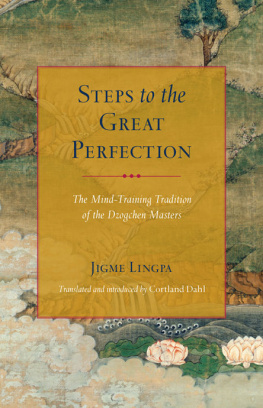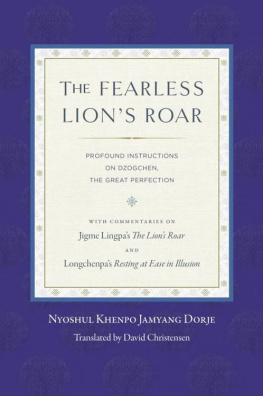Entrance to the Great Perfection
ENTRANCE TO THE
GREAT PERFECTION
A Guide to the Dzogchen Preliminary Practices
Compiled, Translated, and Introduced by
Cortland Dahl
SNOW LION PUBLICATIONS
ITHACA, NEW YORK
Snow Lion Publications
P.O. Box 6483
Ithaca, New York 14851 USA
(607) 273-8519 www.snowlionpub.com
Copyright 2009 Cortland Dahl
All rights reserved. No portion of this book may be reproduced by any
means without prior written permission from the publisher.
Printed in USA on acid-free recycled paper.
ISBN-10: 1-55939-339-4
ISBN-13: 978-1-55939-339-3
Library of Congress Cataloging-in-Publication Data
Entrance to the Great perfection : a guide to the Dzogchen preliminary practices / compiled, translated, and introduced by Cortland Dahl.
p. cm. (The heart essence series)
Includes bibliographical references and index.
ISBN-13: 978-1-55939-339-3 (alk. paper)
ISBN-10: 1-55939-339-4 (alk. paper)
1. Rdzogs-chen. 2. Ri-ma-pa (Sect)RitualsTexts. I. Dahl, Cortland, 1973-BQ7662.4.E58 2010
299.5'4dc22
2009028293
The print edition of this book was designed and typeset by Gopa & Ted2, Inc.
ACKNOWLEDGMENTS
This work would not have been possible without the blessings and guidance of Chatral Sangy Dorj Rinpoche. Rinpoche introduced me to the world of the Longchen Nyingtik and gave me permission to begin practicing its profound teachings. For his boundless blessings and compassion, I will be forever grateful. I am also indebted to Dzongsar Khyentse Rinpoche, who generously allowed me to include his penetrating teachings on the preliminary practices in this volume. In addition, I would like to thank the following teachers for contributing to this book in various ways: Dzogchen Ponlop Rinpoche, Khenpo Sherab Sangpo, Kyabj Trulshik Rinpoche, Kyapchen Tulku Rinpoche, Matthieu Ricard, Semo Saraswati, Shechen Rabjam Rinpoche, Sogyal Rinpoche, Tulku Thondup Rinpoche, and especially Yongey Mingyur Rinpoche. If anything of the profundity of the Great Perfection teachings has made its way into this book, it is due solely to the blessings of these gifted teachers.
I would also like to express my gratitude to all those who helped improve the quality of the translation and introduction. First and foremost, I would like to thank Heidi Nevin for proofing my translation and providing excellent editorial feedback. I would also like to thank Kate Thomas and James Fox for their editorial work and Michael Wakoff at Snow Lion Publications for editing the final manuscript. Finally, I would like to express my gratitude to John Bohumil, Greg Johnson, Lama Tsomo, Mark Ackermoore, and Matthew Pistono for their insightful comments and suggestions concerning my introduction and to Adam Pearcey for helping clear up some difficult points concerning the translation.
There were also many individuals who contributed to the publication of Dzongsar Khyentse Rinpoches commentary. First and foremost, I would like to thank Chanel Grubner for her careful editing work. Additional thanks goes to Doris Wolter for transcribing and editing the teachings, and to all the others who helped support the initial publication of Rinpoches commentary.
This work would never have seen the light of day were it not for the generous support of many individuals. I would especially like to thank David Doth, Dan Pennie, Richard Perkins, and the Khyentse Foundation for sponsoring this project, and all those who have supported the Rim Foundation in recent years, including John Bohumil, Molly Brooks, Kit Dahl, Beth Foss, Deborah Hopp, Evelyn Kaiser, David Lunsford and the Bodhi Foundation, Mary Marsden, Rob McIlhargie, Stephanie Chew Grossman, and the George Family Foundation. I am also grateful to my wife, Tenzin, and my young boy, Sangye, for their love and support, and for putting up with the nomadic lifestyle of a Buddhist translator.
Whatever goodness comes of this project I dedicate to the flourishing of the Great Perfection in all times and places, to the long lives of the masters who uphold its teachings, and to the enlightenment of all beings!
Tsultrim Shnu (Cortland Dahl)
Boudhanath, Nepal
November, 2008
INTRODUCTION
In the winter of 1757, a young man with little formal education but great spiritual potential began a long period of strict retreat in the highlands of central Tibet. In the months and years that followed, he experienced a number of visionary encounters with saints and buddhas, meetings that inspired him to compose some of the greatest masterpieces of Tibetan literature. His fame soon spread, and before long he was reputed to be a living buddha one who has left behind every form of confusion and suffering and manifests the entire range of enlightened qualities. This spiritual adept came to be known as Jigm Lingpa.
To this day, Jigm Lingpas legacy continues to shape the spiritual landscape of the Buddhist world. His philosophical works are studied in many of Tibets prestigious educational institutions, while the ritual liturgies he revealed have become core practices in numerous monastic centers. The instruction manuals he wrote on profound and secret forms of meditation are widely taught to practitioners throughout Tibet and the Himalayas, and now in the West. Jigm Lingpa was also instrumental in training some of the most influential Buddhist masters of his age. Many of the students he taught became great masters, embodying his example of deep meditative realization, profound insight, and vast compassionate activity. Yet despite his renown as a meditation master and philosopher of the highest order, he lived his entire life as a simple yogi, content to spend his days writing, meditating, and guiding the fortunate students with whom he shared a karmic bond.
Of all his achievements, Jigm Lingpas greatest contribution to Buddhism in Tibet lies in a revelatory collection of teachings and practices known as the Longchen Nyingtik, the Heart Essence of the Vast Expanse. The prayers, liturgies, and instruction manuals contained in this collection are at once practical and poetic. Jigm Lingpas elegant aspiration prayers inspire us to look beyond the ordinary deluded habits that propel the mind into suffering, and to refocus instead on the minds true nature and pure expressions. Its liturgical arrangements, or sadhanas , provide a framework for meditation and are capable of transforming confusion into wisdom, eliciting a radical shift in consciousness. Finally, its numerous instruction manuals provide pragmatic advice on virtually every aspect of the spiritual journey, leading the beginning meditator step-by-step along the path of contemplation.
This series of prayers, practices, and meditation manuals lays out a clearly structured path to enlightenment. In the Heart Essence of the Vast Expanse, the spiritual journey begins with a set of preparatory practices, known in Tibet as ngndro . These practices are designed to reorient the mind away from the mundane concerns of ordinary life toward the path to liberation, and then to build on that reorientation by creating an inner environment conducive to spiritual practice. Once the mind has been thoroughly trained and purified by these preliminary practices, the practitioner moves on to a series of advanced meditations that work to undo destructive habitual patterns and reveal the pure, luminous nature of mind that so often goes unnoticed.




